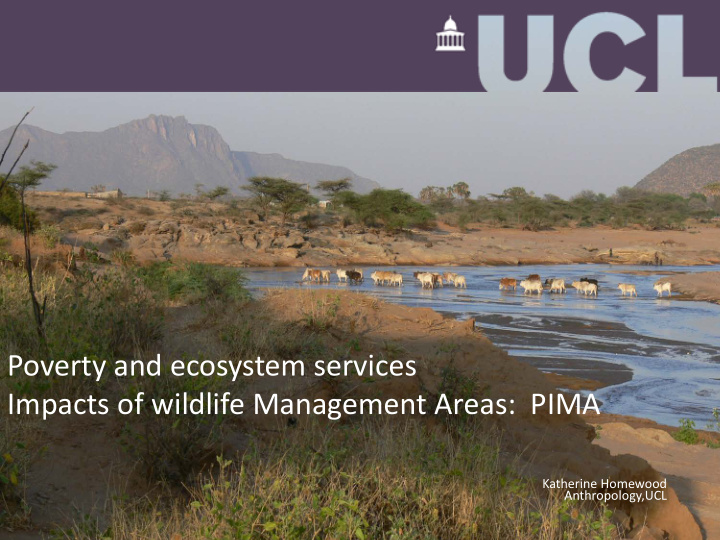



Poverty and ecosystem services Impacts of wildlife Management Areas: PIMA Katherine Homewood Anthropology,UCL
Poverty and ES Impacts of wildlife Management Areas (PIMA) • PIMA project and partners • Research design and methods • Progress to date • Issues • Opportunities • Expected scientific outcomes
Poverty and ES Impacts of Wildlife Management Areas (PIMA) Aidan Keane (Imperial), Maurus Msuha (TAWIRI), Joseph Olila (TNRF), Jens Friis Lund (Copenhagen), Neil Burgess (WCMC)
Tanzania’s Wildlife Management Areas: WMAs • TZ – political legacy Conservation estate • Central control • Community based approach: • CBNRM/PFM policies • Mkukuta I • Mkukuta II • Donor/NGO support • PIMA’s research question: • What are the social and ecological outcomes of WMAs? From WWF-USAID WMA status report 2013
Builds on East African SES • • pastoralist rangeland • miombo woodland • CBNRM/CBC/PFM 1975-present Outcome evaluations: • • Political ecology: Blaikie 2006, Dressler et al 2010 • Ecological: Blomley et al • Institutional: Lund et al • Socio-economic: Homewood et al 2012 • Methodological issues: Jagger et al Past ESPA research: BEST • • how policy/economic incentives shape household decisions • Implications for SES sustainability Evolving practice/ Policy moment • • WWF/USAID WMA status report 2013 • Tanzanian practitioners/ researchers (UDSM; NGOs: AWF, WWF-TZ, TNRF) • TZ Vision 2020
Research design: evaluating conservation/development interventions – Mixed methods – Qualitative validity • Qualitative understanding • Multi-dimensional poverty/wellbeing – Quantitative/ statistical • Causal attribution: – BACI / CI design (Jagger et al: CIFOR; Glew: WWF-US) – Matching ‘Inside’ WMA vs ‘outside’ controls • Rangeland and miombo WMA outcome survey
Northern WMAs: - arid and semi arid - savanna rangeland - migratory wildlife - pastoral grazing - large scale cultivation - tourism
Southern WMAs: - Woodland/ dry forest - Timber - NTFPs - Tourist hunting/ viewing
PIMA Data collection design • Overarching CI design • Build on BA data where available -> BACI subset • Matching WMAs, villages ± households? – Ecological ± Social-economic-cultural variables? • 4 pastoral rangeland + 4 miombo woodland WMAs – Within/between pastoral rangeland vs miombo woodland – For each WMA, 4 villages ‘inside ‘ and 4 ‘outside’ – For each village, 45 hh – For each hh, one male and one female respondent – Survey data: Android tablet/opendatakit – Focus group and KI: hard copy ± e-recording
Selection of study WMAs • Time since inception • Ecosystem type • Availability of • “before” data • aerial counts • Village/hh numbers • Feasibility, familiarity, interest etc...
Preliminary shortlist of WMAs
PIMA’s research question: 1. What are the ecological outcomes of WMAs? • Methods: • Remote sensing (1975-2014) • Aerial census • Ground truthing 2014 • BACI analyses • Variables: • Vegetation cover/ habitat type • % land converted to cultivation / settlement • Wildlife counts • Livestock counts
PIMA’s research question: 2. What are the social outcomes of WMAs? • Methods • Village- and household-level survey • Focus group and key informant interview • Standardised questionnaires spanning N/S differences • Digitised survey • BACI / CI sample and analysis • Variables • Village-level: institutional/ governance change • Household level: for ~45 hh/ village – Livelihoods / Resource use histories – Individual wellbeing change – By gender/wealth etc
Sampling and research process • For BACI subset: • Re-interview all HH where good quality “before” data exist • Match WMA HH to available pool of control HH • Calculate "difference-in-differences” estimator of effect • For CI subset: • "Pre-match" control to WMA villages to focus new data collection • Collect data from stratified sample within control & WMA villages • Match WMA HH to available pool of control HH • Calculate difference btw. matched control and WMA HHs
Progress to date • Start date 1-11-13 • PIMA partner meetings • Scoping WMA selection/ matching • Preparing data collection tools • Ancillary applications • Assembling field team • Inception workshop Arusha, Tanzania: 3.2.14
Issues • Contractual complexities (non EU, non HEI) • Staff turnover (N and S partners) • Data retrieval • Standardised data collection in contrasting sites • EO procedures for field assistant appointments • TZ political sensitivities over land issues 2013:
Opportunities • Balanced partnership growing N-S, N-N and S-S collaborations • Build on/ extend past ESPA-funded research • Extend and leverage networks: • Policymakers • Practitioners • Users • Researchers • Research into practice • What works, where, for whom, why • Policy scenario evaluation
Expected scientific outcomes • New data / analyses • Rigorous qualitative understanding of processes • Rigorous quantitative/ statistical causal attribution • Specific applications: EA savanna+ woodland pastoral /wildlife SES • Evaluating ecological effects in stochastic, dryland environments • Planned scientific publications • Contribution to evidence-based, ecologically and socially sustainable land use across global south
Poverty and ES Impacts of Wildlife Management Areas (PIMA) Aidan Keane (Imperial), Maurus Msuha (TAWIRI), Joseph Olila (TNRF), Jens Friis Lund (Copenhagen), Neil Burgess (WCMC)
Recommend
More recommend